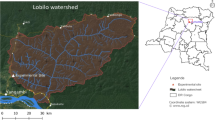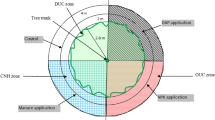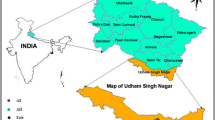Abstract
Tree-crop interactions were monitored by measuring tree growth characters of Prosopis cineraria L. and Tecomella undulata L. and yields of Vigna radiata (L) in agroforestry systems in degraded lands of Indian Desert. Potential competition for resource between the trees and associated crop was analyzed by measuring soil water contents, soil organic matters and NH4-N at different depths of soil layers i.e., 0–25 cm, 25–50 cm and 50–75 cm in the experimental plots. The plots size were 16 m × 18 m (D1), 20 m × 18 m (D2) and 32 m × 18 m (D3) with tree densities of 208, 138 and 104 trees·ha−1 after June 2002, respectively. Results showed that tree height increased by 3% to 7% during June 2002 to June 2004. Collar diameter increased by 30% and 11% in D1, 23% and 19% in D2 and 18% and 36% in D3 plots, respectively, in P. cineraria and T. undulata in two years period. The increase in crown diameter was 9% to 18% in P. cineraria and 11% to 16% in T. undulata. Tree growth was relatively greater in 2002 than in 2003. Yield of V. radiata increased linearly from D1 to D3 plots. Lowest soil water content at 1 m distance from tree base indicated greater utilization of soil water within the tree rooting zone. Concentrations of soil organic matters and NH4-N were the highest (p<0.05) in 0–25 cm soil layer. P. cineraria was more beneficial than T. undulata in improving soil conditions and increasing crop yield by 11.1% and thus more suitable for its integration in agricultural land. The yield of agricultural crop increased when density of tree species was appropriate (i.e., optimum tree density), though it varied with tree size and depended upon resource availability. The result indicated bio-economic benefits of optimum density of P. cineraria and T. undulata over traditional practices of maintaining random trees in farming system in arid zones.
Similar content being viewed by others
References
Abdel Bari E, Fahmy G, Al Thani N, Al Thani R, Abdel-Dayem M. 2007. The Ghaf Tree, Prosopis cineraria in Qatar. Environmental Studies Centre and National Council for Culture, Arts and Heritage, Doha, pp 165.
Aggarwal RK, Kumar P. 1990. Nitrogen response to pearl millet grown on soil underneath P. cineraria and adjacent open site in an arid environment. Annals of Arid Zone, 29: 289–293.
Anderson LS, Sinclair FL. 1993. Ecological interaction in agroforestry systems. Agrofor Abstr, 6: 57–91.
Belsky AJ, Mwonga SM, Amundson RG, Duxbury JM, Ali AR. 1993. Comparative effects of isolated trees on their undercanopy environments in high- and low-rainfall savannas. Journal of Applied Ecology, 30: 143–155.
Dam RF, Mehdi BB, Burgess MSE, Madramootoo CA, Mehuys GR, Callum IR. 2005. Soil bulk density and crop yield under eleven consecutive years of corn with different tillage and residue practices in a sandy loam soil in central Canada. Soil and Tillage Research, 84: 41–53.
Dupraz C. 1999. Adequate design of control treatments in long term agroforestry experiments with multiple objectives. Agroforestry Systems, 43: 35–48.
Elberling BA, Touré K, Rasmussen K. 2003. Changes in soil organic matter following groundnut-millet cropping at three locations in semi-arid Senegal, West Africa. Agriculture, Ecosystems & Environment, 96: 37–47.
Forest Survey of India. 2003. The State of Forest Report. New Delhi: Ministry of Environment and forests, Government of India, pp 116.
Gupta GN, Singh G, Kachhawa GR. 1998. Growth and yield of Prosopis cineraria and associated crops under varying spacing regimes. Agroforestry Systems, 40: 149–157.
Jackson ML. 1973. Soil Chemical Analysis. Prentice Hall of India, New Delhi.
Jiménez JJ, Lal R, Leblanc HA, Russo RO. 2007. Soil organic carbon pool under native tree plantations in the Caribbean lowlands of Costa Rica. Forest Ecology and Management, 241: 134–144.
Jobbágy EG, Jackson RB. 2000. The vertical distribution of soil organic carbon and its relation to climate and vegetation. Ecological Applications, 10: 423–436.
Jose S, Gillespie AR, Seifert JR, Biehle DJ. 2000. Defining competition vectors in a temperate alley cropping system in the Midwestern USA: II. Competition for water. Agroforestry Systems, 48: 41–59.
Joshi DC, Arora BR, Aggarwal RK, Ruhal DC, Sharma BK. 1989. Forms and content of nutrient elements. In: Review on research on sand soils in India. Central Arid Zone research Institute, Jodhpur, India. 85–112 pp.
Lalley JS, Viles HA. 2006. Do vehicle track disturbances affect the productivity of soil-growing lichens in a fog desert? Functional Ecology, 20: 548–556.
Mann HS, Saxena SK. 1980. Khejri (Prosopis cineraria) in the Indian desert its role in agroforestry. CAZRI Monograph No. 11. Jodhpur, India, CAZRI. 93 pp.
Piepho HP, Büchse A, Richter C. 2004. A mixed modeling approach for randomized experiments with repeated measures. Journal of Agronomy and Crop Science, 190: 230–247.
Poffenberger M, Mclean B, Khare A, Campbell J. 1992. Field Methods Manuals, Vol II. Community Forest Economy and Use Pattern: Participatory Rural Appraisal (PRA) Method in South Gujarat. Society for Promotion of Wastelands Development; New Delhi, India.
Livesley SJ, Gregory PJ, Buresh RJ. 2005. Competition in tree row agroforestry systems. 3. Soil water distribution and dynamics. Plant and Soil, 264: 129–139.
NAPCD. 2001. National Action Programme to Combat Desertification. Vol I, Government of India, New Delhi: Ministry of Environment and Forest, pp 18.
Ninari N, Berliner PR. 2002. The role of dew in the water and heat balance of bare Loess soil in the Negev Desert: Quantifying the actual dew deposition on the soil surface. Atmospheric Research, 64: 325–336.
Ninari N, Berliner PR. 2004. Diurnal water content changes in the bare soil of a coastal Desert. Journal of Hydrology, 5: 922–933.
Scanlon BR, Milly PCD. 1994. Water and heat fluxes in desert soils. 2. Numerical simulations. Water Resour Res, 30: 721–733.
Shankarnarayan KA, Harsh LN, Kathju S. 1987. Agroforestry in the arid zones of India. Agroforestry Systems, 5: 69–88.
Singh G, Gupta GN, Kuppusamy V. 2000. Seasonal variations in organic carbon and nutrient availability in arid zone agroforestry systems. Tropical Ecology, 40: 149–155.
Singh G, Rathod TR. 2007. Productivity and soil resource availability in Hardwickia binata based agroforestry system in Indian desert. Arid Land Research and Management, 21: 193–210.
Sokal RR, Rohlf FJ. 1981. Biometry. 2nd edition. New York, USA: W.H. Freeman.
Author information
Authors and Affiliations
Corresponding author
Additional information
Biography: G. Singh (1961– ), male, Scientist E and Head, Division of Forest Ecology, Arid Forest Research Institute, New Pali Road, Jodhpur-342005, India.
Rights and permissions
About this article
Cite this article
Singh, G. Comparative productivity of Prosopis cineraria and Tecomella undulata based agroforestry systems in degraded lands of Indian Desert. Journal of Forestry Research 20, 144–150 (2009). https://doi.org/10.1007/s11676-009-0025-z
Received:
Accepted:
Published:
Issue Date:
DOI: https://doi.org/10.1007/s11676-009-0025-z




